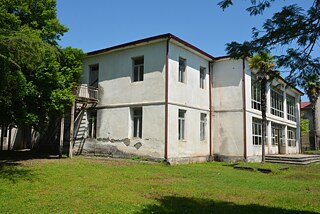Tsalenjikha
The physical mapping process for the municipality included both theoretical and practical aspects for two months. Experts, along with the educational component of the developed mapping methodology, mentored the municipality’s working group through each step of the process.
A detailed list of buildings and spaces was created. To collect information about these objects, research was conducted through inter-sectoral cooperation, fieldwork, and photofilming. The gathered data was then analyzed and recorded on a digital map, and the results were presented.
A detailed list of buildings and spaces was created. To collect information about these objects, research was conducted through inter-sectoral cooperation, fieldwork, and photofilming. The gathered data was then analyzed and recorded on a digital map, and the results were presented.
Physical Mapping Results
In Tsalenjikha Municipality, out of the 20 listed properties, 25% are cultural and creative institutions, and 25% are administrative and commercial buildings. Industrial and production infrastructure accounts for 10%, while hospitality facilities represent 5%. Educational and research institutions, as well as sports infrastructure, each make up 5%.
The usage of listed properties follows as 5% are in active use, 35% are partially utilized, and 60% are nonfunctional.
The structural condition of the mapped buildings is - 10% structurally stable, 40% have minor damage, and 50% are severely damaged.
The ownership of these properties is distributed as follows: 40% are privately owned, 20% are state-owned, and 48% are municipally owned.
Notable buildings include The Cultural House in Zghvaia Settlement, the former Cinema in Zghvaia Settlement, the former Cinema at Shengelaia's House-Museum, Obuji Library, Lia Cultural House, Skuri Sanatorium, the former Kolkhoz Cultural House in Chale, the Tsalenjikha Tea Factory, the former Kolkhoz Building in Mikava, and the former Kolkhoz Cultural House in Mujava.
The usage of listed properties follows as 5% are in active use, 35% are partially utilized, and 60% are nonfunctional.
The structural condition of the mapped buildings is - 10% structurally stable, 40% have minor damage, and 50% are severely damaged.
The ownership of these properties is distributed as follows: 40% are privately owned, 20% are state-owned, and 48% are municipally owned.
Notable buildings include The Cultural House in Zghvaia Settlement, the former Cinema in Zghvaia Settlement, the former Cinema at Shengelaia's House-Museum, Obuji Library, Lia Cultural House, Skuri Sanatorium, the former Kolkhoz Cultural House in Chale, the Tsalenjikha Tea Factory, the former Kolkhoz Building in Mikava, and the former Kolkhoz Cultural House in Mujava.






